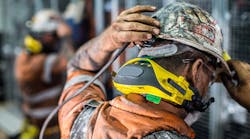Dr. Alex Birrell, CEO of CleanSpace, recently sat down for a Q&A with EHS Today that focuses on personal protective equipment (PPE) in general and respiratory protection in particular. She provides insight on what to consider when deciding on the type of equipment needed for workers and your environment and how to decide when it’s time to invest in new PPE. Birrell, who also has an MBA, discusses how the use of the correct PPE and the protection of employees can help your business strategy, the potential impact of new OSHA regulations, how technology is changing the industry and the reasons she believes there are so many non-compliance issues with respirators.
CleanSpace is based in Australia, and was established in 2009 by a medical device engineering team with a vision to make respiratory protection wearable and easy-to-use. Since that time, the company broadened its reach to include respiratory protection for a number of industries.
In 2014, Birrell was named in the 2014 Australian Financial Review and Westpac 100 Women of Influence Awards. At the time, she noted, “I feel honored to join such an impressive group of women recognized this year and previous years. The recognition brings into focus our vision for all staff working with airborne hazards to have access to easy-to-use, comfortable and high protection respiratory masks. Without this, they risk long-term health issues that affect themselves, their families and the community. Our impact is to have long-term improvements in global workplace safety.”
EHS Today: What should companies consider when deciding on the type of equipment needed for their workers/environment?
Alex Birrell: In order to be compliant with workplace safety laws, companies must regularly review equipment related to their respiratory protection programs. Equipment selection must be made in the context of the hazards, tasks and other PPE or tools used by staff. In selecting respirators HSE managers look to three key selection criteria:
- Protection factors suitable for their site;
- User acceptance and compliance (comfort, ease of use, availability and compatibility with other equipment), and;
- The total cost of ownership for the business (inventory, maintenance, cleaning and use of consumables).
Respirators are technically complex and often interpreted as confusing for employees. Selecting equipment that is easy-to-use, available when they need it and comfortable is the key to compliance.
EHS Today: When is it time to invest in new PPE?
Alex Birrell: This depends. Large companies (with multiple operations, tasks, hazards and sites) will be constantly reviewing their safety programs and PPE. As part of their duty-of-care and legal obligations, safety and plant managers and officers of the company should constantly be evaluating industry best practices and new equipment that improves worker protection/health. Investing in new PPE, after a review of the requirements, will deliver direct and immediate financial returns to the company in terms of improved safety/liability, compliance and productivity.
EHS Today: How can investing in PPE help a company’s business strategy?
Alex Birrell: Updating safety equipment is always in line with leading businesses’ strategies where it improves worker protection, productivity and efficiency to create healthier companies. Other benefits include lower costs for inventory and equipment cleaning/management impact profitability.
New technologies such as connectivity and data enabled devices – well underway in other industries – are transformative for business management and create platforms for management to make informed and timely decision making. Just as important are the indirect positive effects from improved culture and employee engagement when they see the business investing in their health and comfort at work.
EHS Today: What is the impact of the new OSHA silica standard as well as other workplace respiratory concerns?
Alex Birrell: Clinical evidence and knowledge of the dangers of workplace hazards grows every year. Fifty years ago, a common construction material, asbestos, was revealed to cause aggressive and irreversible cancers, and new laws to protect workers were written.
More recently, OSHA (OSHA 29 CFR 1926.1153 Respirable Crystalline Silica in Construction and OSHA 29 CFR 1910 General Industry regulations) has implemented its new silica standards, which acknowledge the health effects of crystalline silica dust. [The standards] raise the level of respiratory protection that employers and contractors have to provide in cutting, crushing or grinding concrete and hard rock.
Also in 2017, the WHO reclassified welding fumes from potential carcinogen to a known carcinogen (Group 1). No one wants workers to be exposed to airborne carcinogenic dust/fumes.
These two events alone suggest that many construction and manufacturing operations should consider the use of daily respiratory protection in the same way that hard hats are worn daily across the worksite. The right choice of PPE will have very real, practical implications for training, deployment and ongoing management for these businesses.
EHS Today: How is technology is changing the PPE industry?
Alex Birrell: Safety and protective equipment is traditionally a low innovation area. But new technology in the area of materials, fabrics and electronics have dramatically improved worker comfort, heat stress, availability/usability and protective qualities.
Connectivity and the IoT (Internet of Things) is poised to be the next game changer for safety managers to employ safety programs that are cost-effective, scalable and provide point-of-wearer information. As consumers, we use these new technologies every day via our smart phones. In a phenomenally short period of time, these connected technologies have transformed our lives for the better.
The low barriers to entry (online subscriptions) allow smart business managers to build a business case for change without heavy investment in time or money.
EHS Today: Why are there so many non-compliance issues with respirators and how can it be combated?
Alex Birrell: There has been no innovation in respirators for 20 years. Whether workers are required to wear a disposable mask (N95) or a powered belt-mounted respirator, the traditional products offerings are uncomfortable.
Disposables allow heat and moisture to build up in the mask and restrict breathing. Powered respirators are heavy and cumbersome and neither of them are modern looking or help you speak to your team.
Like the steel-toed boots, respirators have to protect as well as be comfortable and allow for movement. [For manufacturers,] designing work wear that workers want to wear is the key to compliance. Using innovative materials and consumer designs in today’s market, normalizes workplace PPE and delivers the comfort that workers require.
EHS Today: You mentioned that non-compliance is an issue, and that PPE must be comfortable and easy-to-use for employees to want to comply with regulations and company policies. Would you suggest engaging employees or employee representatives in trying new PPE to help promote employee acceptance of new equipment?
Alex Birrell: Absolutely! And when considering or re-evaluating respiratory protection, always seek expert advice and recommendations from a safety or respiratory protection specialist. A risk assessment will identify the type and level of protection required. Done well, businesses can be OSHA compliant, improve the efficiency of their operations and save direct and long-term costs.


